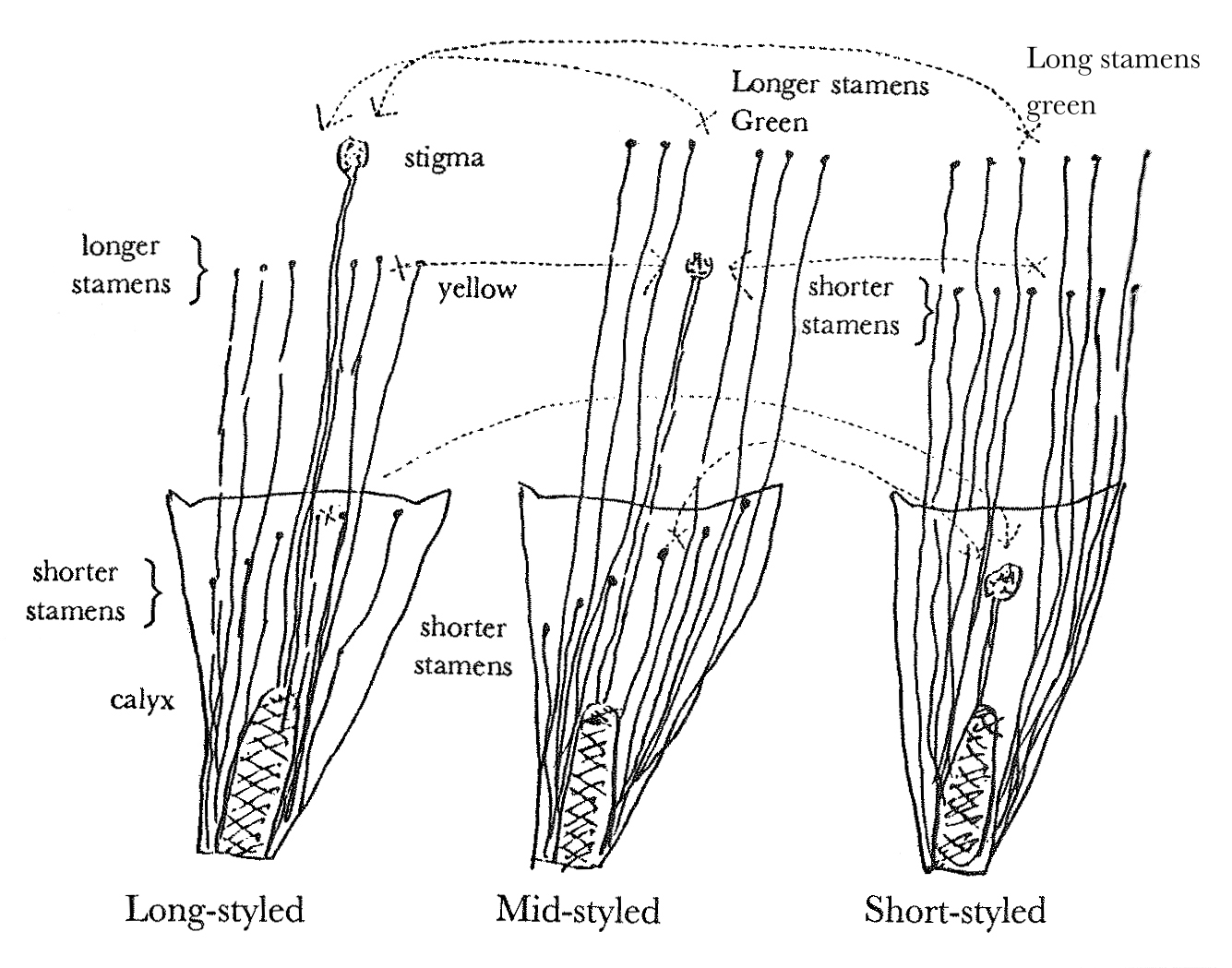My dear William.—
I am very sorry to hear about your mare. I never knew what an unfortunate family we are in horse-flesh. It really is most provoking.—2 Mamma orders me to compliment you on what a capital hand you have taken to write: it is very good. Aunt Susan was much pleased with your very nice note to her, which she sent on to us.—3
Now for business: Lythrum is a really wonderful case & will be worth an enormous amount of labour; & labour, by Jove, there will be, for I find I must castrate every flower. It will be a grand ending to my work on dimorphism.— The enclosed splendid diagram shows what I have hardly a doubt is the case: you must study it; the red lines show which pollen will fertilise which stigmas;4 all the other crosses I expect to be sterile or little fertile. In the long-styled (your long pistilled)5 the longer anthers are always yellow: has not this deceived you about maturity of flowers? Please let me hear.— I had overlooked difference in colour of filaments;— thanks.—
It wd. be enormous advantage if you could have patience to gather at least 100 twigs & class them, & then I shd. give fact on your authority:6 employ the Boys;7 but caution them to gather only one twig from each plant.— I noticed slight difference in pollen of long & short stamens in the long-styled; & considerable difference between green & yellow pollen in the mid- & the short-styled plants. I wanted 3 good specimens. (not crushed with little damp, not wet, moss) to compare pollens: I suspect those that go in pairs in diagram are alike or nearly alike.—
I dare not trust specimens in my garden for some are monstrous. I also wanted specimens from same locality to get relative heights of stamens & pistils, & to put in spirits for Artist. You will not have time to do it; but if you could make me with camera in same position outlines of all six pollens, I would have them engraved from your outlines: these outlines would show whether there are three or more than three sizes & shapes. Pollen had better be dry; it sticks to glass I find; but whether when perpendicular I know not. But I do not think you will have time for the outlines.—8
If my diagram is the truth, is it not very curious & complex case? nothing like it, is known in whole organic world. See how well corresponding heights will carry pollen on proboscis from flower to flower. Do Humble or Hive-bees visit the flowers? ask George to see to this.—
Did you say that the other sp. of Lythrum grows with you?—Vaucher says it has only 2 forms;9 I am intensely curious to see them; & if you can I would get you in autumn to send me 3 or 4 plants of each kind.
GoodBye my dearest old man.— Lenny is going on very well.10 We are perplexed to death what to do. The Doctors urge in strongest terms to avoid all chance of infection; so did my Father in bad cases, & this has been very bad. All the children are now perfectly safe, if we can avoid future infection.—11
C. Darwin
I think I have plants enough of Lythrum salicaria, but could you mark two of mid-styled.
Sunday Evening
P.S. I kept back my letter, because I received this morning the specimens.12 They have been very useful: I return stamps. I am perplexed about pollen, & I believe I must measure all again distended by water: the breadth of dry grains seem to vary much from some cause.— Will you mark with string (3 strings for long-styled, 2 for mid & 1 for short-styled) 3 plants of Lythrum, as I much want a few pods, (wrapped up separately when ripe) to count seeds in each, to know natural product, & to compare shape of pods.—
George is a rare hand at watching insects13 & beg him to observe carefully what part of body of bee the knobbed stigma of long & mid-styled rubs against, when Bee sucking: no doubt the short anthers & stigma of short-styled rubs against the proboscis. After a Bee has visited several flowers of mid- & short-styled & long-styled flowers, it would be grand to catch him & kill him & see with lens whether one part of body did not abound with the green pollen & another part with yellow. Ask George to study my diagram & he will see what I mean; it is like the two pollens of Cowslip on proboscis of moth & Bees.
George ought to look out for Epipactis latifolia now in flower, & see what insects visit it.14 Good Night— Lenny sat in arm-chair for an hour.— Goodnight my three dear Boys.— | C. D.
I shall weary you about Lythrum.
[Enclosure]15

Manuscript Alterations and Comments
Please cite as “DCP-LETT-3678,” in Ɛpsilon: The Charles Darwin Collection accessed on